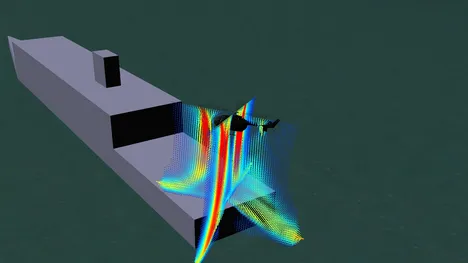Rotorcraft Downwash and Dynamic Interface Modeling for Real-Time Simulations in Naval Applications

This project concerns the development and validation of a computationally efficient analytical tool for coupled ship/aircraft dynamic interface modeling and simulation. The technical approach realizes the coupling of a novel Lattice-Boltzmann based fluid simulation model with the ship airwake and rotor aerodynamics (inflow) modeling, including the feedback on the flight dynamics and handling qualities for piloted simulation of rotorcraft.
In naval operations, rotorcraft downwash may interact with stationary or moving obstacles, and objects such as a (moving) ship structure. Moreover, interferences between rotor wake and ship airwake and/or varying wind fields lead to substantial modifications to the rotor inflow which affects the rotorcrafts’ handling qualities. Thus, maneuvers in vicinity of terrain and complex obstacles, such as landing and take-off on ship decks and oil platforms, account for the most demanding and hazardous situations in rotorcraft operations. However, these interactions are not yet implemented in piloted training simulations in an adequate manner. One reason for these shortcomings lies in the significant computational requirements for physically accurate modeling of the complex flow environment and, therefore, in the inadequacy of such numerical models for real-time training simulation. To overcome these deficiencies, a Lattice-Boltzmann based model for real-time simulation of the flow field generated by and interacting with the helicopter was developed, extended and coupled to rotorcraft flight dynamics. The model opens up the possibility to capture arbitrary, complex and moving boundary conditions, and to calculate aircraft- and flight-state specific flow fields in real-time. In contrast to existing simulation approaches that are encumbered by the need for look-up tables and preexisting measurements (e.g., of the ship airwake), boundary conditions are realized at simulation run-time using ray-tracing algorithms. As part of the model development, the flow model is modified for the simulation of dynamic rotor wake interaction with ship airwake, wind, and ship motion. A dynamic interface is implemented and the downwash model’s output is used as input to the rotor (inflow) aerodynamics modeling for piloted simulations. Therefore, feedback is enabled of the complex flow field to rotorcraft flight dynamics and pilot handling qualities.
To ensure compliance with the underlying physical phenomena, dynamic interface measurements of collaborating research teams at the U.S. Naval Academy and the George Washington University are used for model validation, and piloted evaluation of the model’s fidelity is used to adjust model parameters. The described model/simulation will provide a better understanding of the interactional aerodynamics in shipborne operations and the impact of the complex flow environment on rotor inflow, rotorcraft flight dynamics, and pilot handling qualities. The model development culminates in a model that can be used for pilot training simulation, e.g., landing on moving ship decks under the influence of strong winds, improving pilot and crew training in such critical and hazardous situations.
Publications
- Bludau J., Rauleder J., Hajek M.: Validation of a Dynamic Inflow Model Based on a Flight Dynamics Model and a Lattice-Boltzmann Fluid Solver Using Flight Test Data, 43rd European Rotorcraft Forum, Milan, Italy, 2017.
Contact
Jakob Bludau, M.Sc.
Bastian Horvat, M.Sc.